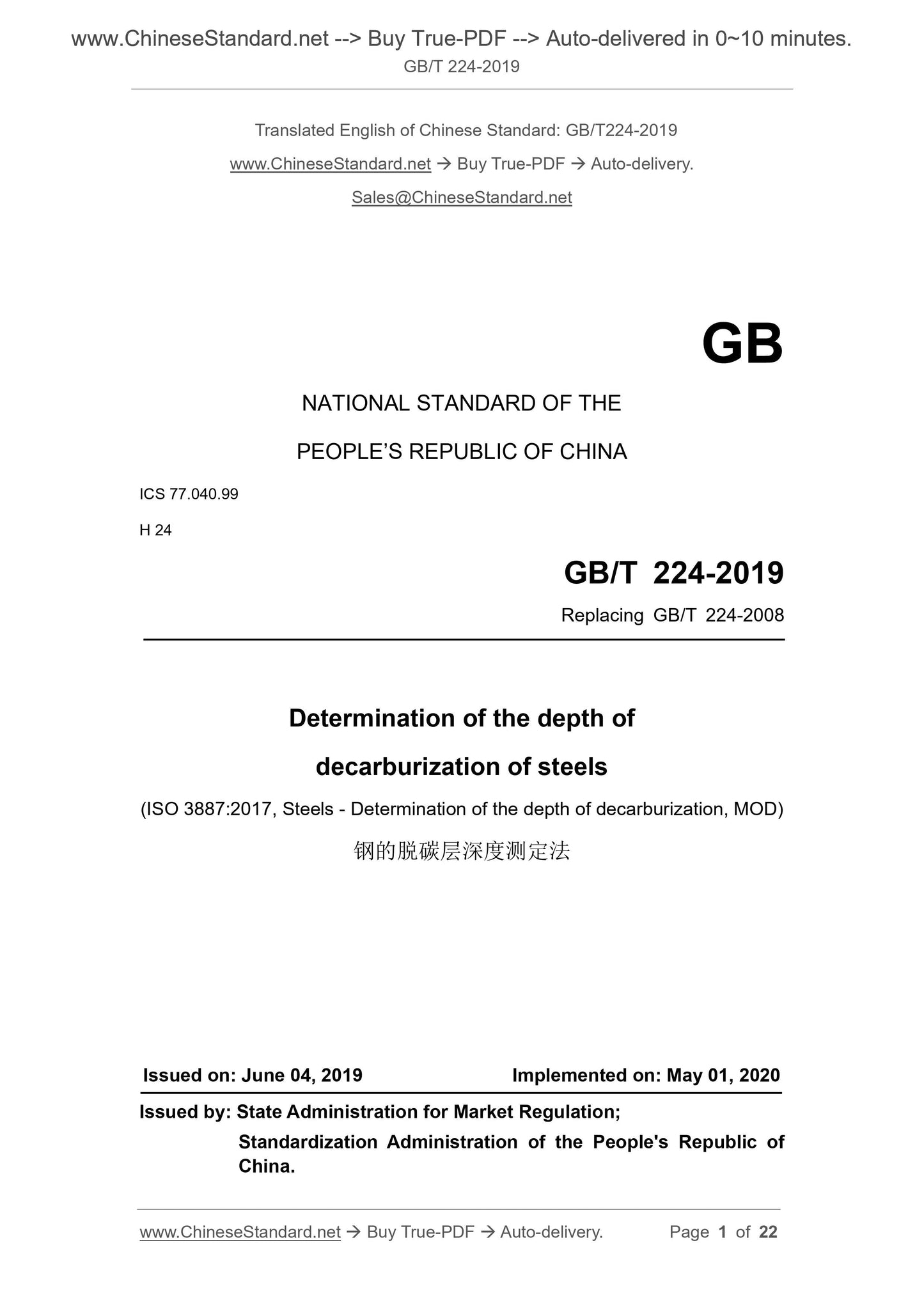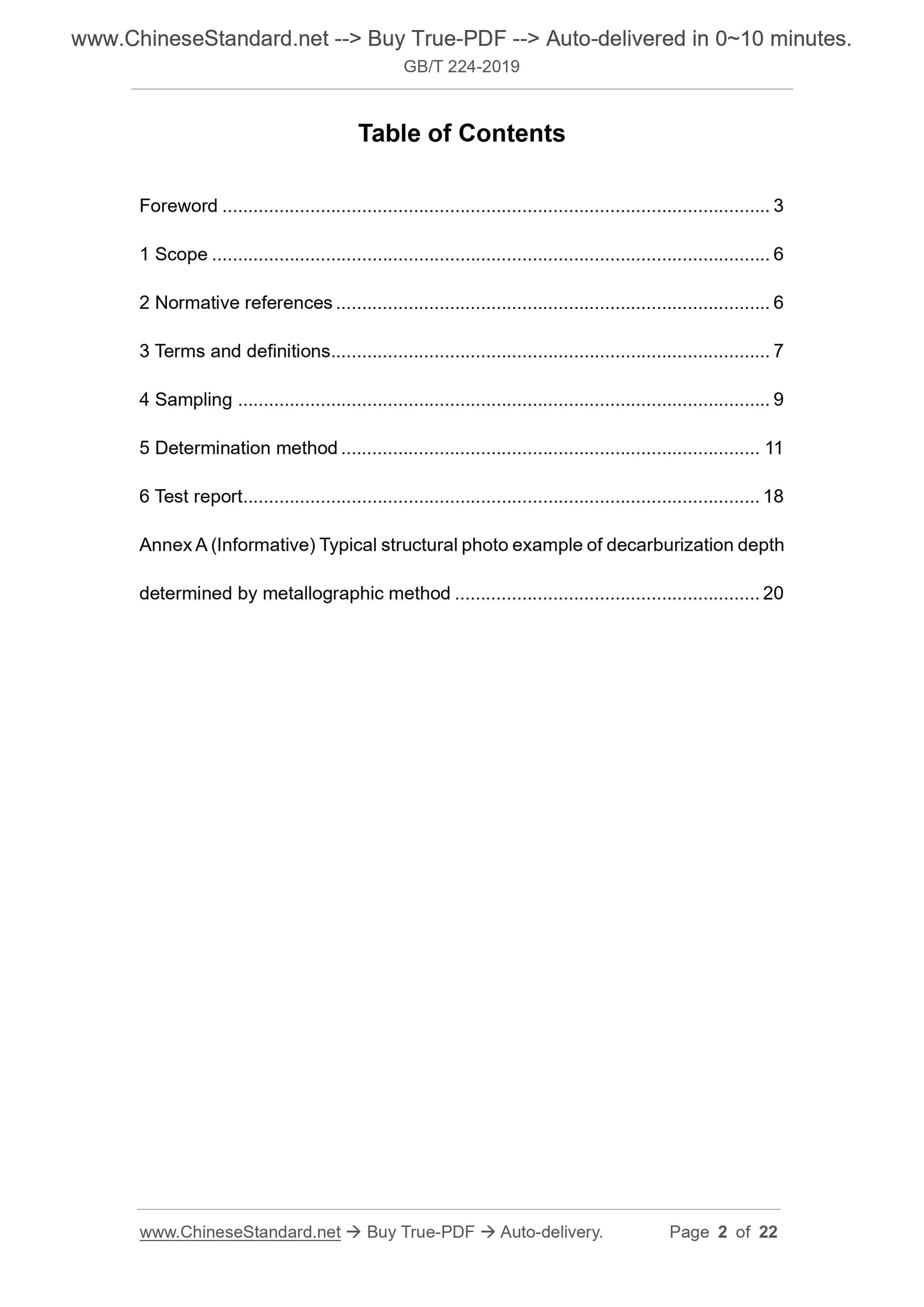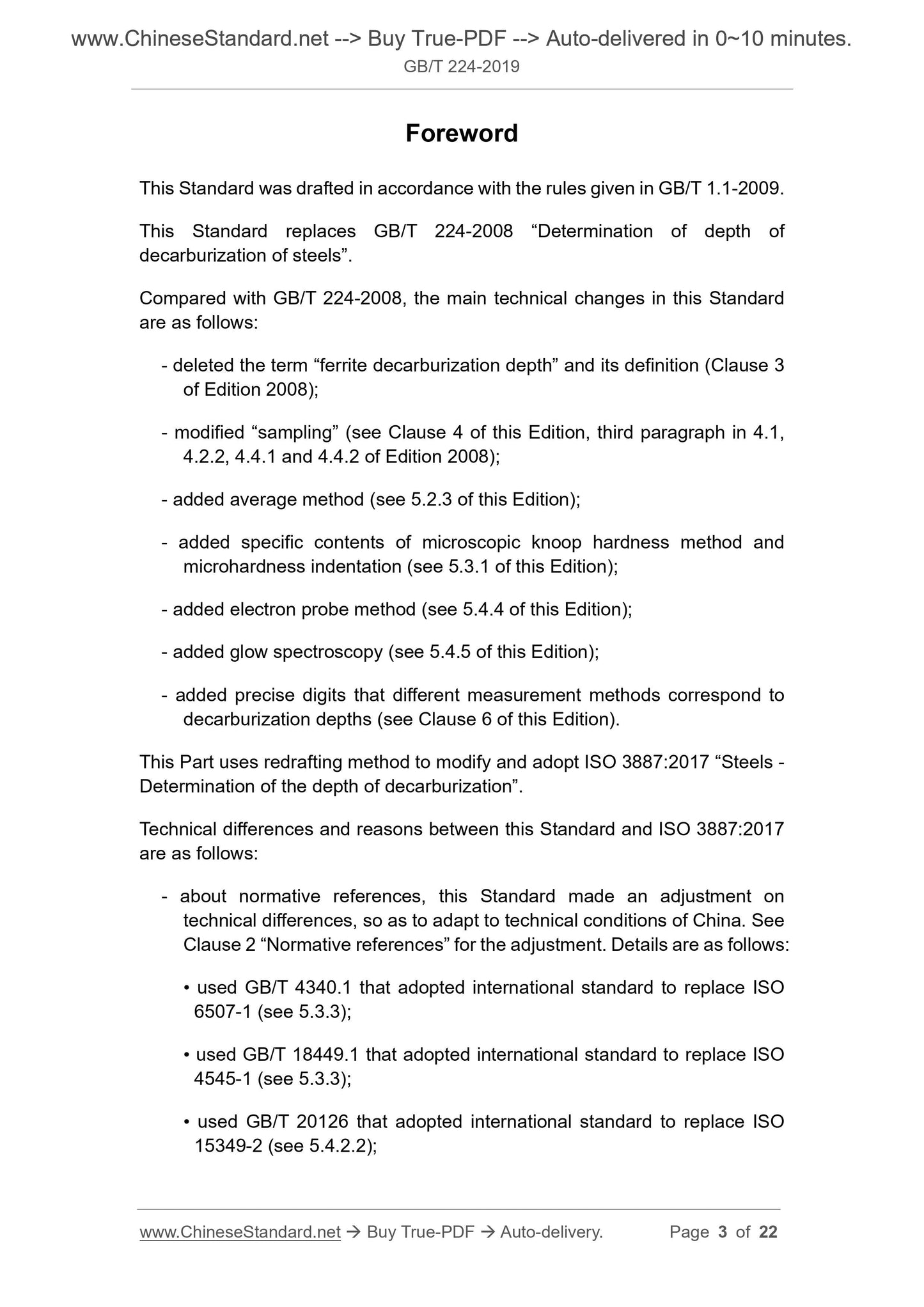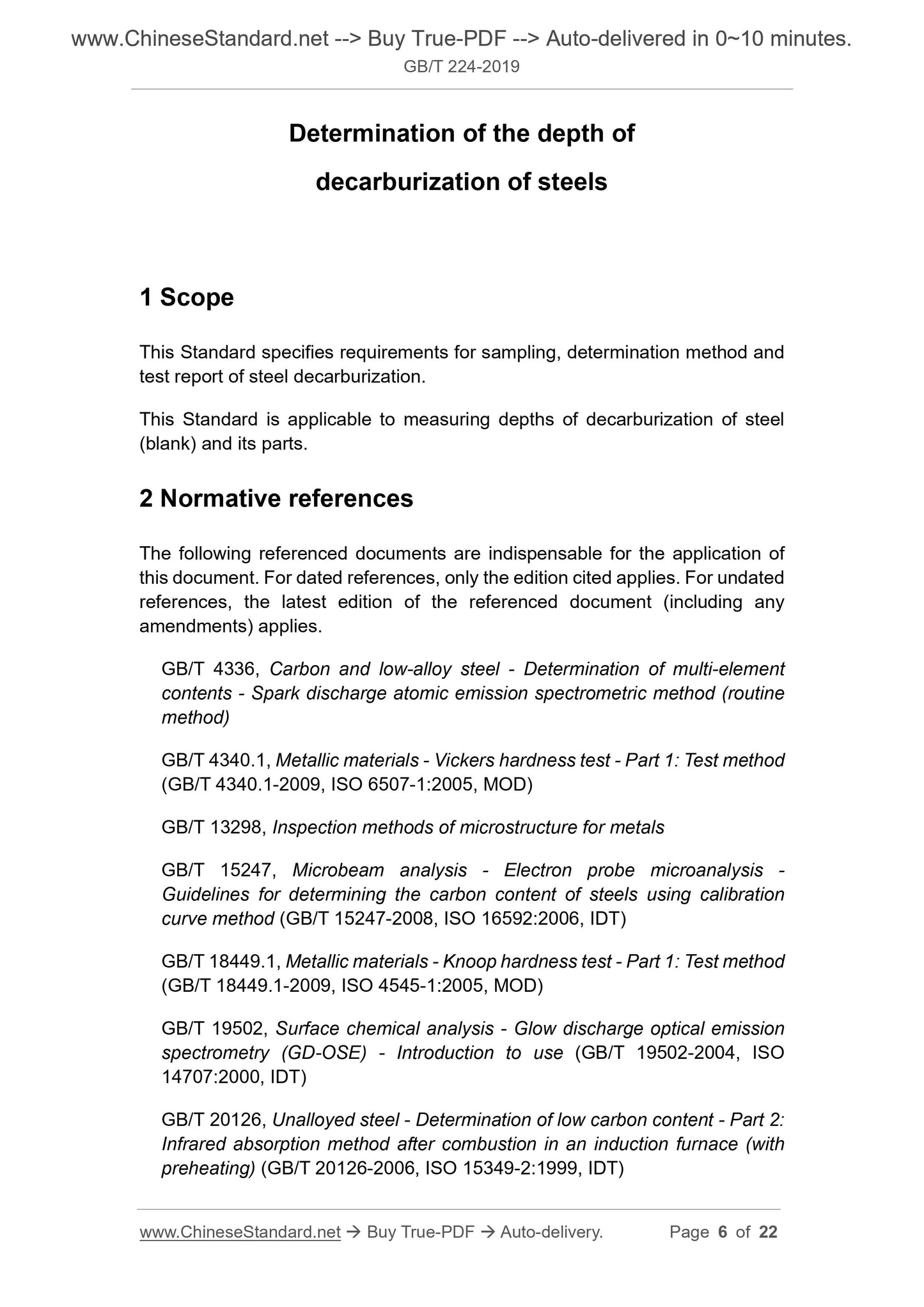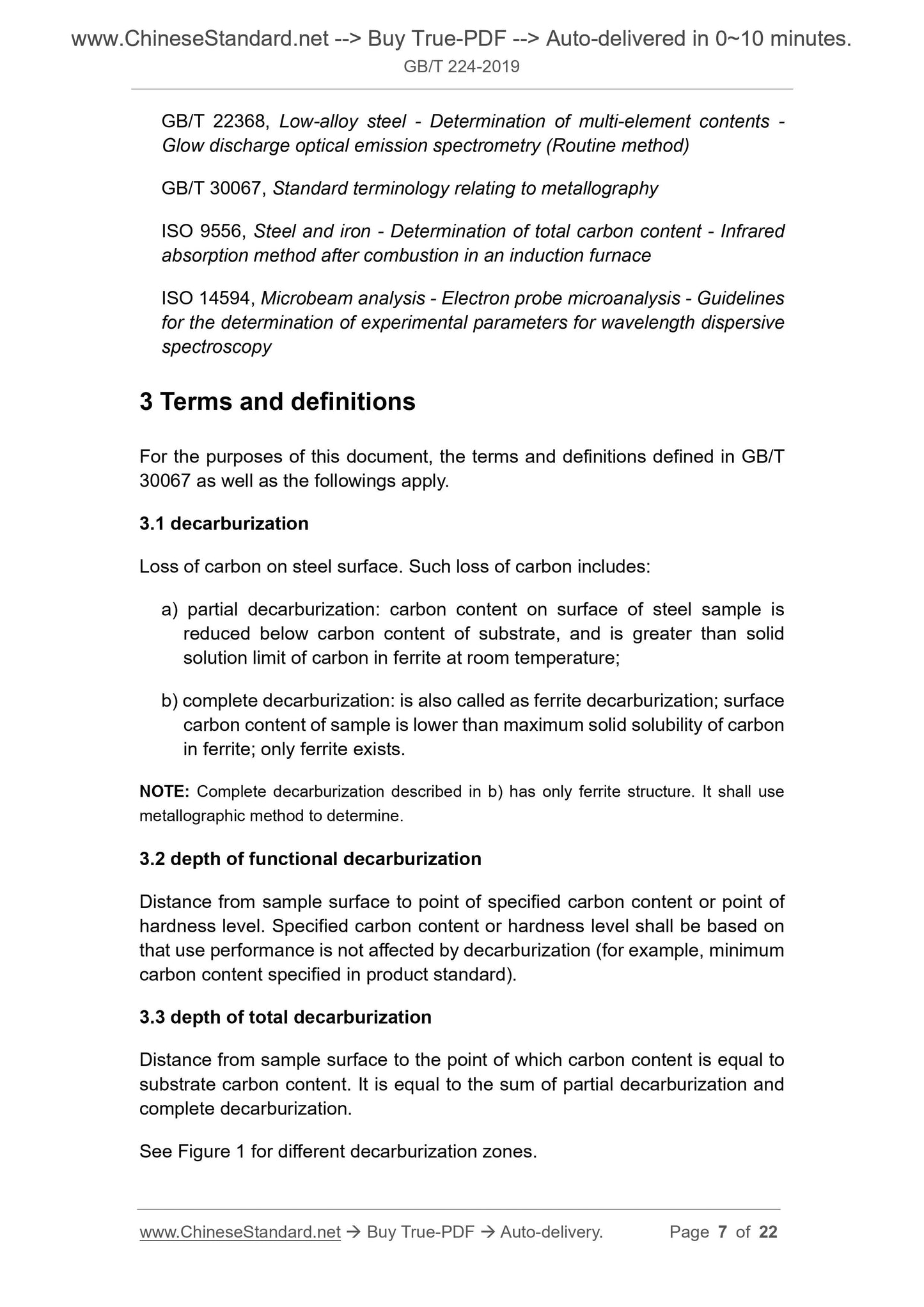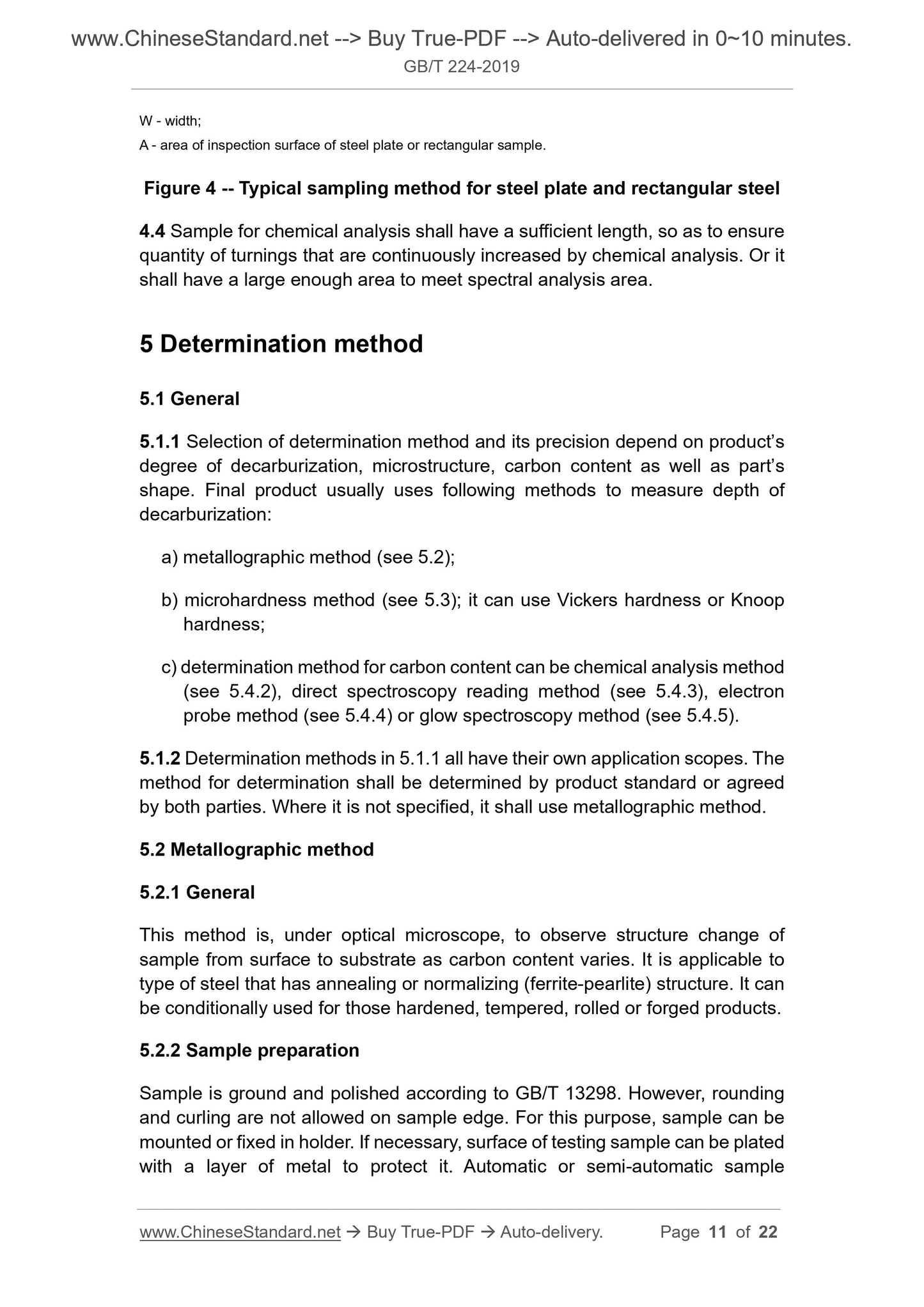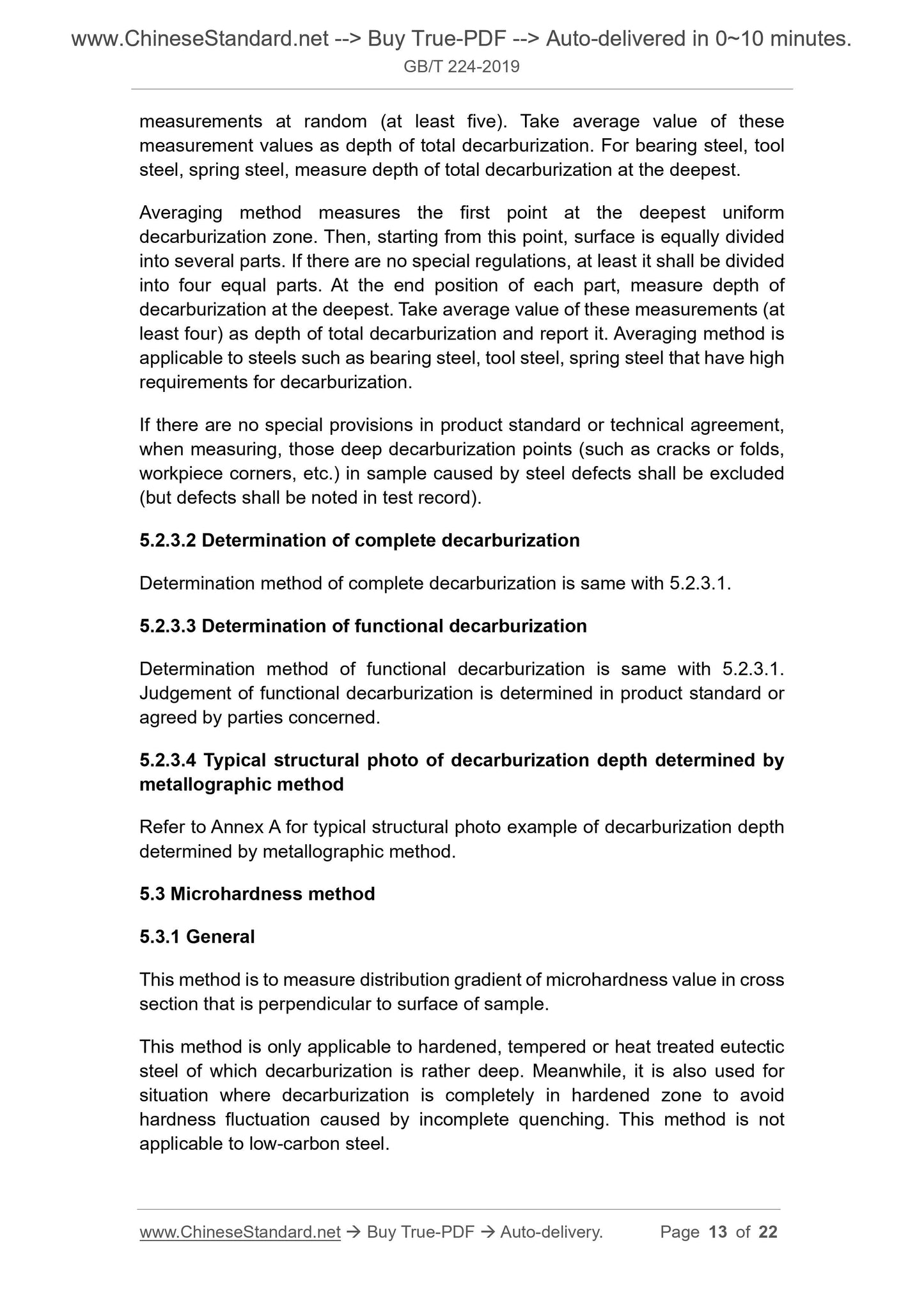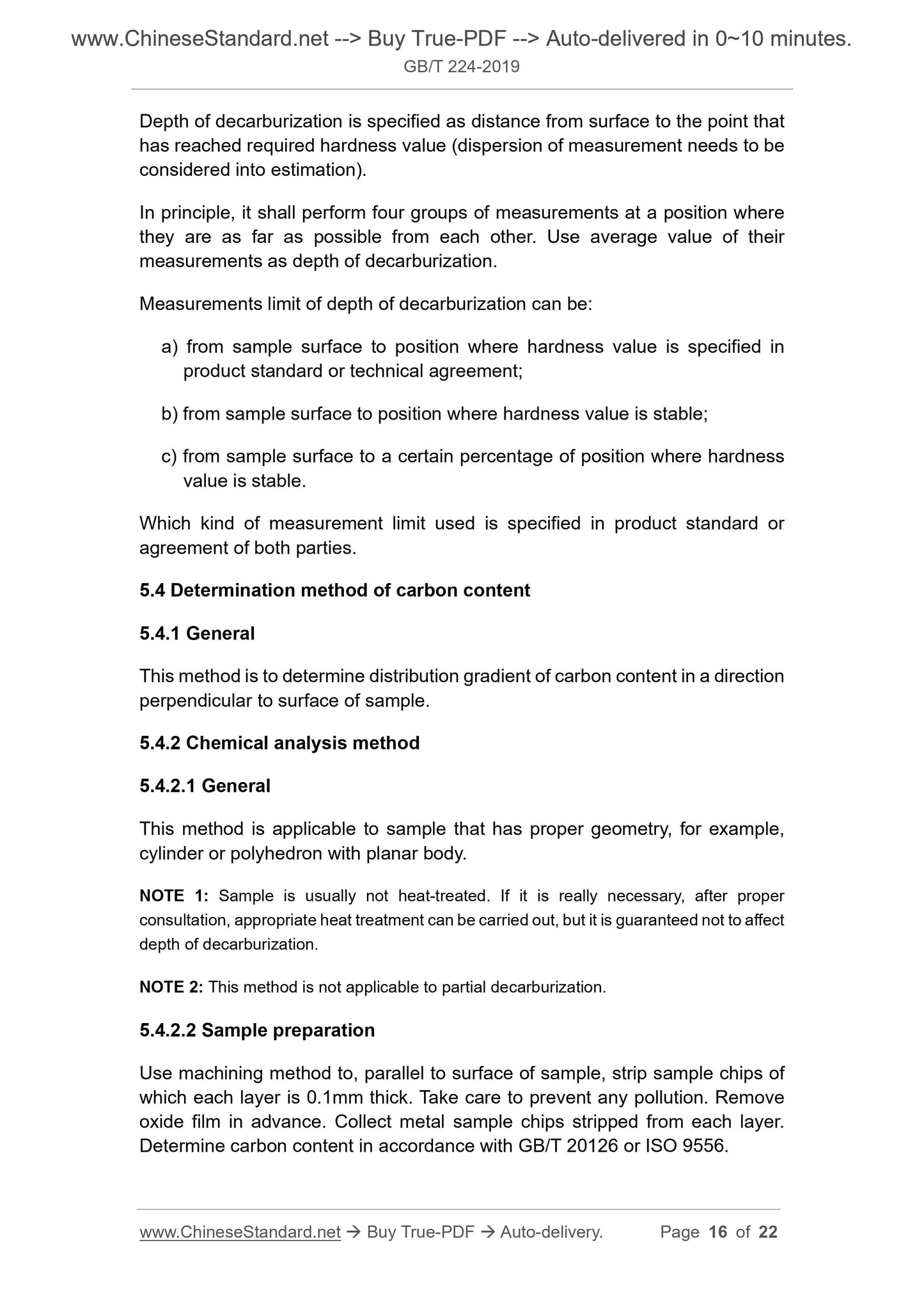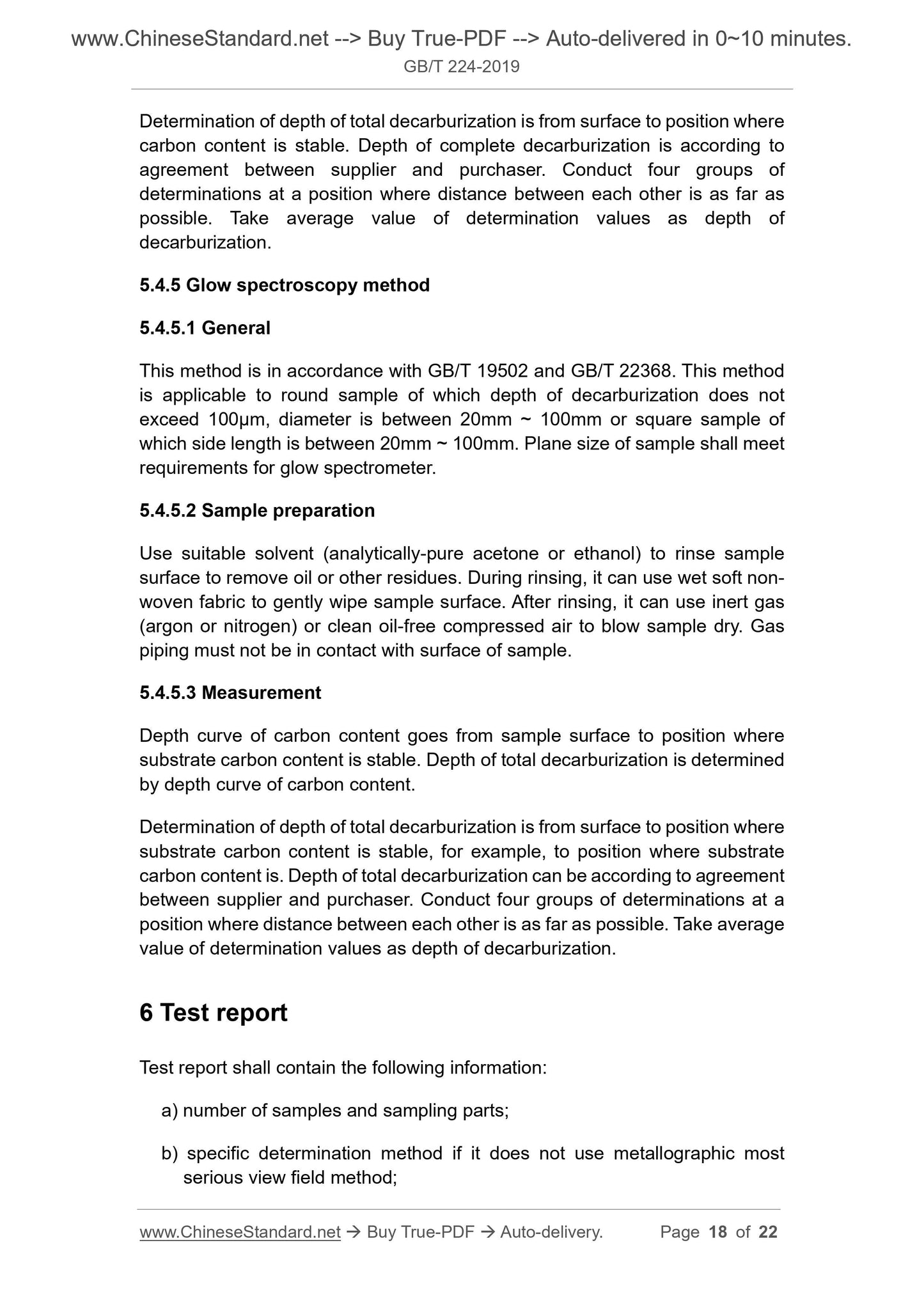1
/
of
9
PayPal, credit cards. Download editable-PDF and invoice in 1 second!
GB/T 224-2019 English PDF (GBT224-2019)
GB/T 224-2019 English PDF (GBT224-2019)
Regular price
$145.00 USD
Regular price
Sale price
$145.00 USD
Unit price
/
per
Shipping calculated at checkout.
Couldn't load pickup availability
Delivery: 3 seconds. Download true-PDF + Invoice.
Get QUOTATION in 1-minute: Click GB/T 224-2019
Historical versions: GB/T 224-2019
Preview True-PDF (Reload/Scroll if blank)
GB/T 224-2019: Determination of the depth of decarburization of steels
GB/T 224-2019
NATIONAL STANDARD OF THE
PEOPLE’S REPUBLIC OF CHINA
ICS 77.040.99
H 24
Replacing GB/T 224-2008
Determination of the depth of
decarburization of steels
(ISO 3887:2017, Steels - Determination of the depth of decarburization, MOD)
ISSUED ON: JUNE 04, 2019
IMPLEMENTED ON: MAY 01, 2020
Issued by: State Administration for Market Regulation;
Standardization Administration of the People's Republic of
China.
Table of Contents
Foreword ... 3
1 Scope ... 6
2 Normative references ... 6
3 Terms and definitions ... 7
4 Sampling ... 9
5 Determination method ... 11
6 Test report ... 18
Annex A (Informative) Typical structural photo example of decarburization depth
determined by metallographic method ... 20
Foreword
This Standard was drafted in accordance with the rules given in GB/T 1.1-2009.
This Standard replaces GB/T 224-2008 “Determination of depth of
decarburization of steels”.
Compared with GB/T 224-2008, the main technical changes in this Standard
are as follows:
- deleted the term “ferrite decarburization depth” and its definition (Clause 3
of Edition 2008);
- modified “sampling” (see Clause 4 of this Edition, third paragraph in 4.1,
4.2.2, 4.4.1 and 4.4.2 of Edition 2008);
- added average method (see 5.2.3 of this Edition);
- added specific contents of microscopic knoop hardness method and
microhardness indentation (see 5.3.1 of this Edition);
- added electron probe method (see 5.4.4 of this Edition);
- added glow spectroscopy (see 5.4.5 of this Edition);
- added precise digits that different measurement methods correspond to
decarburization depths (see Clause 6 of this Edition).
This Part uses redrafting method to modify and adopt ISO 3887:2017 “Steels -
Determination of the depth of decarburization”.
Technical differences and reasons between this Standard and ISO 3887:2017
are as follows:
- about normative references, this Standard made an adjustment on
technical differences, so as to adapt to technical conditions of China. See
Clause 2 “Normative references” for the adjustment. Details are as follows:
• used GB/T 4340.1 that adopted international standard to replace ISO
6507-1 (see 5.3.3);
• used GB/T 18449.1 that adopted international standard to replace ISO
4545-1 (see 5.3.3);
• used GB/T 20126 that adopted international standard to replace ISO
15349-2 (see 5.4.2.2);
Determination of the depth of
decarburization of steels
1 Scope
This Standard specifies requirements for sampling, determination method and
test report of steel decarburization.
This Standard is applicable to measuring depths of decarburization of steel
(blank) and its parts.
2 Normative references
The following referenced documents are indispensable for the application of
this document. For dated references, only the edition cited applies. For undated
references, the latest edition of the referenced document (including any
amendments) applies.
GB/T 4336, Carbon and low-alloy steel - Determination of multi-element
contents - Spark discharge atomic emission spectrometric method (routine
method)
GB/T 4340.1, Metallic materials - Vickers hardness test - Part 1: Test method
(GB/T 4340.1-2009, ISO 6507-1:2005, MOD)
GB/T 13298, Inspection methods of microstructure for metals
GB/T 15247, Microbeam analysis - Electron probe microanalysis -
Guidelines for determining the carbon content of steels using calibration
curve method (GB/T 15247-2008, ISO 16592:2006, IDT)
GB/T 18449.1, Metallic materials - Knoop hardness test - Part 1: Test method
(GB/T 18449.1-2009, ISO 4545-1:2005, MOD)
GB/T 19502, Surface chemical analysis - Glow discharge optical emission
spectrometry (GD-OSE) - Introduction to use (GB/T 19502-2004, ISO
14707:2000, IDT)
GB/T 20126, Unalloyed steel - Determination of low carbon content - Part 2:
Infrared absorption method after combustion in an induction furnace (with
preheating) (GB/T 20126-2006, ISO 15349-2:1999, IDT)
GB/T 22368, Low-alloy steel - Determination of multi-element contents -
Glow discharge optical emission spectrometry (Routine method)
GB/T 30067, Standard terminology relating to metallography
ISO 9556, Steel and iron - Determination of total carbon content - Infrared
absorption method after combustion in an induction furnace
ISO 14594, Microbeam analysis - Electron probe microanalysis - Guidelines
for the determination of experimental parameters for wavelength dispersive
spectroscopy
3 Terms and definitions
For the purposes of this document, the terms and definitions defined in GB/T
30067 as well as the followings apply.
3.1 decarburization
Loss of carbon on steel surface. Such loss of carbon includes:
a) partial decarburization: carbon content on surface of steel sample is
reduced below carbon content of substrate, and is greater than solid
solution limit of carbon in ferrite at room temperature;
b) complete decarburization: is also called as ferrite decarburization; surface
carbon content of sample is lower than maximum solid solubility of carbon
in ferrite; only ferrite exists.
NOTE: Complete decarburization described in b) has only ferrite structure. It shall use
metallographic method to determine.
3.2 depth of functional decarburization
Distance from sample surface to point of specified carbon content or point of
hardness level. Specified carbon content or hardness level shall be based on
that use performance is not affected by decarburization (for example, minimum
carbon content specified in product standard).
3.3 depth of total decarburization
Distance from sample surface to the point of which carbon content is equal to
substrate carbon content. It is equal to the sum of partial decarburization and
complete decarburization.
See Figure 1 for different decarburization zones.
W - width;
A - area of inspection surface of steel plate or rectangular sample.
Figure 4 -- Typical sampling method for steel plate and rectangular steel
4.4 Sample for chemical analysis shall have a sufficient length, so as to ensure
quantity of turnings that are continuously increased by chemical analysis. Or it
shall have a large enough area to meet spectral analysis area.
5 Determination method
5.1 General
5.1.1 Selection of determination method and its precision depend on product’s
degree of decarburization, microstructure, carbon content as well as part’s
shape. Final product usually uses following methods to measure depth of
decarburization:
a) metallographic method (see 5.2);
b) microhardness method (see 5.3); it can use Vickers hardness or Knoop
hardness;
c) determination method for carbon content can be chemical analysis method
(see 5.4.2), direct spectroscopy reading method (see 5.4.3), electron
probe method (see 5.4.4) or glow spectroscopy method (see 5.4.5).
5.1.2 Determination methods in 5.1.1 all have their own application scopes. The
method for determination shall be determined by product standard or agreed
by both parties. Where it is not specified, it shall use metallographic method.
5.2 Metallographic method
5.2.1 General
This method is, under optical microscope, to observe structure change of
sample from surface to substrate as carbon content varies. It is applicable to
type of steel that has annealing or normalizing (ferrite-pearlite) structure. It can
be conditionally used for those hardened, tempered, rolled or forged products.
5.2.2 Sample preparation
Get QUOTATION in 1-minute: Click GB/T 224-2019
Historical versions: GB/T 224-2019
Preview True-PDF (Reload/Scroll if blank)
GB/T 224-2019: Determination of the depth of decarburization of steels
GB/T 224-2019
NATIONAL STANDARD OF THE
PEOPLE’S REPUBLIC OF CHINA
ICS 77.040.99
H 24
Replacing GB/T 224-2008
Determination of the depth of
decarburization of steels
(ISO 3887:2017, Steels - Determination of the depth of decarburization, MOD)
ISSUED ON: JUNE 04, 2019
IMPLEMENTED ON: MAY 01, 2020
Issued by: State Administration for Market Regulation;
Standardization Administration of the People's Republic of
China.
Table of Contents
Foreword ... 3
1 Scope ... 6
2 Normative references ... 6
3 Terms and definitions ... 7
4 Sampling ... 9
5 Determination method ... 11
6 Test report ... 18
Annex A (Informative) Typical structural photo example of decarburization depth
determined by metallographic method ... 20
Foreword
This Standard was drafted in accordance with the rules given in GB/T 1.1-2009.
This Standard replaces GB/T 224-2008 “Determination of depth of
decarburization of steels”.
Compared with GB/T 224-2008, the main technical changes in this Standard
are as follows:
- deleted the term “ferrite decarburization depth” and its definition (Clause 3
of Edition 2008);
- modified “sampling” (see Clause 4 of this Edition, third paragraph in 4.1,
4.2.2, 4.4.1 and 4.4.2 of Edition 2008);
- added average method (see 5.2.3 of this Edition);
- added specific contents of microscopic knoop hardness method and
microhardness indentation (see 5.3.1 of this Edition);
- added electron probe method (see 5.4.4 of this Edition);
- added glow spectroscopy (see 5.4.5 of this Edition);
- added precise digits that different measurement methods correspond to
decarburization depths (see Clause 6 of this Edition).
This Part uses redrafting method to modify and adopt ISO 3887:2017 “Steels -
Determination of the depth of decarburization”.
Technical differences and reasons between this Standard and ISO 3887:2017
are as follows:
- about normative references, this Standard made an adjustment on
technical differences, so as to adapt to technical conditions of China. See
Clause 2 “Normative references” for the adjustment. Details are as follows:
• used GB/T 4340.1 that adopted international standard to replace ISO
6507-1 (see 5.3.3);
• used GB/T 18449.1 that adopted international standard to replace ISO
4545-1 (see 5.3.3);
• used GB/T 20126 that adopted international standard to replace ISO
15349-2 (see 5.4.2.2);
Determination of the depth of
decarburization of steels
1 Scope
This Standard specifies requirements for sampling, determination method and
test report of steel decarburization.
This Standard is applicable to measuring depths of decarburization of steel
(blank) and its parts.
2 Normative references
The following referenced documents are indispensable for the application of
this document. For dated references, only the edition cited applies. For undated
references, the latest edition of the referenced document (including any
amendments) applies.
GB/T 4336, Carbon and low-alloy steel - Determination of multi-element
contents - Spark discharge atomic emission spectrometric method (routine
method)
GB/T 4340.1, Metallic materials - Vickers hardness test - Part 1: Test method
(GB/T 4340.1-2009, ISO 6507-1:2005, MOD)
GB/T 13298, Inspection methods of microstructure for metals
GB/T 15247, Microbeam analysis - Electron probe microanalysis -
Guidelines for determining the carbon content of steels using calibration
curve method (GB/T 15247-2008, ISO 16592:2006, IDT)
GB/T 18449.1, Metallic materials - Knoop hardness test - Part 1: Test method
(GB/T 18449.1-2009, ISO 4545-1:2005, MOD)
GB/T 19502, Surface chemical analysis - Glow discharge optical emission
spectrometry (GD-OSE) - Introduction to use (GB/T 19502-2004, ISO
14707:2000, IDT)
GB/T 20126, Unalloyed steel - Determination of low carbon content - Part 2:
Infrared absorption method after combustion in an induction furnace (with
preheating) (GB/T 20126-2006, ISO 15349-2:1999, IDT)
GB/T 22368, Low-alloy steel - Determination of multi-element contents -
Glow discharge optical emission spectrometry (Routine method)
GB/T 30067, Standard terminology relating to metallography
ISO 9556, Steel and iron - Determination of total carbon content - Infrared
absorption method after combustion in an induction furnace
ISO 14594, Microbeam analysis - Electron probe microanalysis - Guidelines
for the determination of experimental parameters for wavelength dispersive
spectroscopy
3 Terms and definitions
For the purposes of this document, the terms and definitions defined in GB/T
30067 as well as the followings apply.
3.1 decarburization
Loss of carbon on steel surface. Such loss of carbon includes:
a) partial decarburization: carbon content on surface of steel sample is
reduced below carbon content of substrate, and is greater than solid
solution limit of carbon in ferrite at room temperature;
b) complete decarburization: is also called as ferrite decarburization; surface
carbon content of sample is lower than maximum solid solubility of carbon
in ferrite; only ferrite exists.
NOTE: Complete decarburization described in b) has only ferrite structure. It shall use
metallographic method to determine.
3.2 depth of functional decarburization
Distance from sample surface to point of specified carbon content or point of
hardness level. Specified carbon content or hardness level shall be based on
that use performance is not affected by decarburization (for example, minimum
carbon content specified in product standard).
3.3 depth of total decarburization
Distance from sample surface to the point of which carbon content is equal to
substrate carbon content. It is equal to the sum of partial decarburization and
complete decarburization.
See Figure 1 for different decarburization zones.
W - width;
A - area of inspection surface of steel plate or rectangular sample.
Figure 4 -- Typical sampling method for steel plate and rectangular steel
4.4 Sample for chemical analysis shall have a sufficient length, so as to ensure
quantity of turnings that are continuously increased by chemical analysis. Or it
shall have a large enough area to meet spectral analysis area.
5 Determination method
5.1 General
5.1.1 Selection of determination method and its precision depend on product’s
degree of decarburization, microstructure, carbon content as well as part’s
shape. Final product usually uses following methods to measure depth of
decarburization:
a) metallographic method (see 5.2);
b) microhardness method (see 5.3); it can use Vickers hardness or Knoop
hardness;
c) determination method for carbon content can be chemical analysis method
(see 5.4.2), direct spectroscopy reading method (see 5.4.3), electron
probe method (see 5.4.4) or glow spectroscopy method (see 5.4.5).
5.1.2 Determination methods in 5.1.1 all have their own application scopes. The
method for determination shall be determined by product standard or agreed
by both parties. Where it is not specified, it shall use metallographic method.
5.2 Metallographic method
5.2.1 General
This method is, under optical microscope, to observe structure change of
sample from surface to substrate as carbon content varies. It is applicable to
type of steel that has annealing or normalizing (ferrite-pearlite) structure. It can
be conditionally used for those hardened, tempered, rolled or forged products.
5.2.2 Sample preparation
Share
